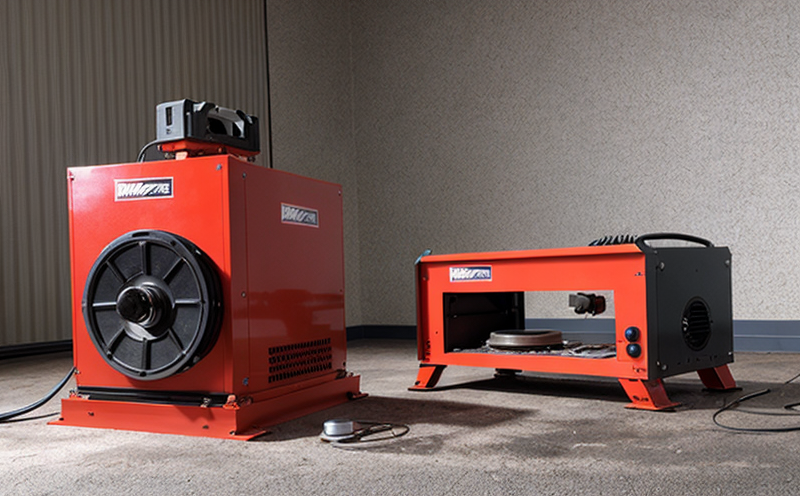IEC 60068-2-6 Sinusoidal Vibration Testing
The IEC 60068-2-6 sinusoidal vibration test is a critical method for assessing the durability and reliability of products under simulated real-world conditions. This standard, developed by the International Electrotechnical Commission (IEC), specifies the procedures for conducting sinusoidal vibration tests on electrical and electronic equipment to ensure they withstand mechanical stress without failure.
During this type of testing, samples are subjected to controlled frequencies in the range of 10 Hz up to a maximum frequency specified by the test conditions. The amplitude is typically set at 25 g or 40 g peak-to-peak (pp), depending on the product's design and expected operating environment. This level of vibration can simulate various transportation, manufacturing, and usage conditions, thereby providing insights into how well a product will perform under stress.
The test setup involves placing the sample on a shaker table that oscillates in a sinusoidal pattern to produce the required frequency and amplitude. The testing duration is also specified within IEC 60068-2-6, typically lasting from several minutes up to hours based on the product's expected lifespan.
The goal of this test is not only to evaluate the structural integrity but also to understand how repeated mechanical stress affects electrical connections and components. By conducting such tests, manufacturers can ensure that their products meet quality standards before entering production or being deployed in real-world applications.
- Customer Impact: Ensures long-term reliability of equipment used in harsh environments.
- Satisfaction: Reduction in product failures and warranty claims due to premature wear and tear.
The detailed process involves careful preparation of the specimen, including alignment with the shaker table and securing it properly. It is crucial that the sample does not move during testing, as this could lead to inaccurate results or damage to the equipment being tested. Post-testing analysis focuses on examining any visible signs of damage or changes in performance metrics such as electrical resistance or temperature rise.
By adhering to IEC 60068-2-6 guidelines, manufacturers can demonstrate compliance with international standards and ensure their products meet rigorous quality assurance criteria. This testing methodology plays a vital role in the design and manufacturing phases of many industries, particularly those dealing with electronic devices exposed to significant mechanical stress.
Scope and Methodology
The scope of IEC 60068-2-6 covers the testing procedures for sinusoidal vibration tests on electrical and electronic equipment, including devices that may be subject to mechanical stress during use. The methodology specifies the frequency range (10 Hz – up to the maximum specified by test conditions), amplitude levels (typically 25 g or 40 g peak-to-peak), and duration of testing.
The vibration test is conducted on a shaker table where the sample is placed in a predefined position. The shaker generates sinusoidal motion, which causes the sample to experience controlled vibrations along one axis at first. Depending on the specific requirements outlined by IEC 60068-2-6, multiple axes may be tested sequentially or simultaneously.
For each test condition, detailed procedures are provided for setting up and operating the shaker system. These include calibration of the shaker to ensure accurate frequency output, ensuring proper alignment of the sample on the table, and applying appropriate dampers and mounts to prevent unwanted movement during testing.
The acceptance criteria for this type of testing involve evaluating the sample's behavior throughout the test period, including visual inspection for any visible damage or changes in performance metrics. If the sample passes all specified tests without sustaining unacceptable damage, it is deemed compliant with IEC 60068-2-6.
Customer Impact and Satisfaction
The impact of IEC 60068-2-6 sinusoidal vibration testing extends beyond mere compliance with international standards; it significantly enhances customer satisfaction through improved product reliability. By ensuring that products undergo rigorous testing under simulated real-world conditions, manufacturers can reduce the likelihood of failures in harsh environments.
- Reduction in Product Failures: Ensuring that products are robust enough to handle mechanical stress reduces the incidence of breakdowns and other issues that could lead to customer dissatisfaction.
- Decreased Warranty Claims: Products that meet these stringent testing requirements tend to have lower rates of warranty claims, thereby improving overall customer satisfaction.
- Better Quality Assurance: Compliance with international standards like IEC 60068-2-6 demonstrates a commitment to quality assurance, which builds trust among customers and stakeholders.
These benefits translate into higher levels of customer confidence and loyalty. Manufacturers who invest in thorough testing not only enhance their reputation but also contribute positively to the overall satisfaction of end users.
Use Cases and Application Examples
The IEC 60068-2-6 sinusoidal vibration testing is widely applicable across various sectors, including automotive electronics, aerospace components, consumer electronics, and medical devices. Here are some specific use cases:
- Automotive Electronics: Testing the durability of electrical control units in cars exposed to road vibrations.
- Aerospace Components: Ensuring that avionics systems can withstand launch vibrations during rocket launches.
- Consumer Electronics: Assessing the reliability of smartphones and other portable devices when transported over rough terrains.
- Medical Devices: Verifying that medical instruments like pacemakers remain functional even after being subjected to frequent handling and transport.
In each case, IEC 60068-2-6 provides a standardized approach to simulating real-world conditions, allowing manufacturers to make informed decisions about product design and manufacturing processes. This ensures that end users receive products that are not only innovative but also reliable in challenging environments.





